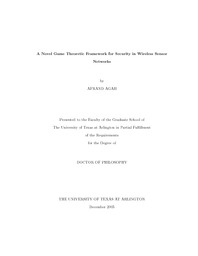| dc.contributor.author | Agah, Afrand | en_US |
| dc.date.accessioned | 2007-08-23T01:56:27Z | |
| dc.date.available | 2007-08-23T01:56:27Z | |
| dc.date.issued | 2007-08-23T01:56:27Z | |
| dc.date.submitted | November 2005 | en_US |
| dc.identifier.other | DISS-1114 | en_US |
| dc.identifier.uri | http://hdl.handle.net/10106/308 | |
| dc.description.abstract | Due to severe resource limitations and often lack of centralized infrastructure, providing security in wireless sensor networks is a great challenge. Misbehavior due to malicious or faulty nodes can significantly degrade the performance of such networks. Therefore, countermeasures against denial of service (DoS) attacks and node misbehavior are essential requirements. We argue that the conventional view of security based on cryptography techniques is not sufficient for securing wireless sensor networks. In this dissertation, we investigate a novel framework by proposing three approaches for security enforcement in such networks that range from prevention of DoS attacks to secure routing. Prevention of DoS attacks focuses on the formal assessment of the properties of cooperation enforcement mechanisms used to detect and prevent malicious behavior of sensor nodes.
Our first proposed approach is called Utility based Dynamic Source Routing (UDSR). It is based on non-cooperative game theory, where players of the game are sensor nodes. Players can occasionally misbehave. In this game, we demonstrate that in order to reach equilibrium, where no rational player has any incentive to deviate and to maximize the profit for the network (i.e., the least amount of false detections), a sensor network shall isolate those nodes that act maliciously. These nodes have the minimum amount of utility in the game. This approach provides an automatic method for the social mechanisms of reputation and cooperation.
Our second proposed approach is called Secure Auction based Routing (SAR). The assumption is that rational players always plan to maximize their profit over time. Here the key to solve this problem is when a node uses other nodes in the network to forward its own packets, it has to contribute to the network life ( by forwarding other nodes packets) in order to be entitled to use them in the future. To enable such networks to keep functioning despite the presence of misbehaving nodes, we propose a mechanism such that nodes prefer to gain reputation in the network. Nodes willing to do so must compete against each other, where the competition is based on auction theory. A node's truthful bidding remains a dominant strategy and to have a secure routing protocol, malicious nodes who do not bid truthfully shall be isolated.
Our third proposed approach deals with detection of malicious nodes, based on repeated games. The benefit of this approach is the impact of a large group of players in the sense that the strategy chosen by a player does not only depend on one malicious node's perception of the game, but also on the group policy for all players. The strategy of a sensor node is to decide whether to cooperate with other nodes. This approach identifies non participating nodes and isolates them. We show that infinite repetition can be the key for obtaining equilibrium behavior, which could not be reached if the game were played once or for a known finite number of times. Implementation results on a sensor network testbed indicate that the repeated game based approach, conditioned on past histories of players, detects the malicious nodes more accurately. | en_US |
| dc.description.sponsorship | Das, Sajal | en_US |
| dc.language.iso | EN | en_US |
| dc.publisher | Computer Science & Engineering | en_US |
| dc.title | A Novel Game Theoretic Framework For Security In Wireless Sensor Networks | en_US |
| dc.type | Ph.D. | en_US |
| dc.contributor.committeeChair | Das, Sajal | en_US |
| dc.degree.department | Computer Science & Engineering | en_US |
| dc.degree.discipline | Computer Science & Engineering | en_US |
| dc.degree.grantor | University of Texas at Arlington | en_US |
| dc.degree.level | doctoral | en_US |
| dc.degree.name | Ph.D. | en_US |
| dc.identifier.externalLink | https://www.uta.edu/ra/real/editprofile.php?onlyview=1&pid=177 | |
| dc.identifier.externalLinkDescription | Link to Research Profiles | |

